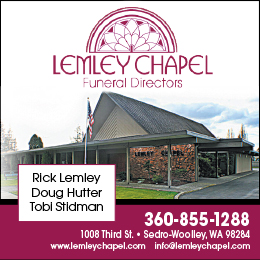Commentary: Outside Envision 2060, peering in
By Joline Bettendorf
When I was 10 years old, our Sunday school teacher asked us what we thought heaven was like. I said I thought it was just like Skagit County, which ended that conversation. In the intervening 68 years I haven’t changed my vision of heaven. Even though Skagit County is not as heavenly as I remember, enough remains to hope for more careful stewardship now and in the future.
Project Envision 2060, sponsored by the county planning department, indicates others are alarmed about the results of past development. A committee of twelve conscientious citizens from diverse backgrounds, guided by the planning department and a steering committee, studied development issues and will soon recommend to the county commissioners policies based on the priorities of the Urban Land Institute. The 2060 Committee’s leaders have provided the public with informational pamphlets, presentations by national experts, and solicited participation through community sessions and a Web site (www.skagitcounty.net/envisionskagit). The Envision project will recommend a plan for development and the Commissioners will make policy.
It is in the interest of all Skagitonians to follow this process and speak up about the Committee’s proposals even though understanding the issues of development from outside the process is time-consuming and complicated.
The Envision process
It is possible to be dubious about the Envision 2060 process and the committee’s recommendations without doubting the sincerity of the effort, but asking for public comments at tightly controlled public meetings came very late in the process, after a favored plan was chosen. This was guaranteed to create mistrust and suspicion that there are manipulators with hidden motives behind the scenes. I am dismayed at the direction in which I see the conclusions and recommendations heading, and that there is no one evaluating the process or the assumptions or conclusions the committee is promoting. There is no reason that the public should accept the committee’s assumptions as unassailable fact or to unquestioningly accept the committee’s plan.
I’m especially dubious about the hard sell for the trendy concept of small houses on small lots in densely packed towns for this county. Envision 2060’s visiting experts (Robert Lang, Bill Kreager, and others connected to the Urban Land Institute), as well as a blitz of pro-development articles and books paint unrealistically rosy pictures of the joys of living in exactly the kind of housing and neighborhoods people my age happily fled. We know that reality. That was all we could afford, and many of us got out as soon as we had a choice, and choice, diversity, and individuality are missing from the “smaller-is-better,” “crowded-together-is-better” juggernaut.
These are the assumptions the committee does not question:
1. We must save the agricultural and forest lands and water resources, protect them from the oncoming necessity to develop.
2. At least 100,000 people (double today’s population) are coming to Skagit County in the next 50 years. They cannot be stopped.
3. We must accommodate them.
4. The model developed by Oregon State University, based on the Urban Land Institute’s (ULI) members’ interests, should guide development policies here.
5. People no longer want detached single-family units with large yards but want to live in densely populated communities in small houses or apartments with no yards.
6. We must build in towns and villages or new, self-contained communities to spare natural resource lands from development.
Assumption 1: We cannot allow further building on natural resource lands.
This assumption is endorsed by a majority who participated in the community meetings. It is inarguable that the county should guard the natural resources that protect health and livelihoods—agricultural and forest lands, waters and their sources, and the incomparable, invaluable landscape and wildlife habitats. This is common and economic sense, and what public opinion asserts is valuable about living in this special place.
Assumption 2: In the next 50 years, one hundred thousand people will move here, doubling the population. They cannot be stopped.
People move for three primary reasons: a preferred way of life, inexpensive housing, jobs.
A preferred way of life here for many is rural. We trade the amenities of cities for what is special here: unique small towns separated by farms and nearby open space; access to locally produced food; space for gardens (many Skagitonians are fanatic gardeners for whom a yard is an amenity, not a burden); space and privacy without isolation; cities within easy travel time.
We are told we must sacrifice these qualities of small-town life or lose the open space; there are no other options.
Inexpensive housing is one way to ensure an influx of population. In other areas, cheaper and larger houses enticed workers to commute long distances, which, in turn, created a demand to accommodate increasingly more cars, roads, bridges, and parking lots. The western United States does not have highly developed public transportation systems, or reasonably expect ever to have them. A huge influx of twice as many residents here will bring pressure for increased room for cars, continuing the cycle of opening land for more buildings, which increases traffic, which brings demands for more roads, which brings more building.
Why encourage more inexpensive housing and more accommodations for cars, which will put unresistable pressure to build in small towns and on rural lands? Farmable acreage already has been lost to road building, and the county commissioners will establish eminent domain taking of property to allow more (Skagit Valley Herald, May 18, 2011).
Jobs are a magnet for new populations. Absent an expanded transportation system, a population double the size of the current one will require an industrial base we do not have and do not want. Enough jobs for this supposed population growth would bring more commercial building and new or wider roads encroaching on agricultural and open land.
Assumption 3: We must accommodate the newcomers by building more housing.
Why must we? Who will benefit from this influx? Why build to be inviting to this many new inhabitants who will require infrastructure built with tax money and cause more crowded neighborhoods and streets and more commercial building? If there are no jobs and no housing, there will be few incentives to move here and work elsewhere. To paraphrase: If you build it they will come; if you don’t build it, they can’t come.
This doubled population growth estimate seems based on growth during the previous 50 years and growth patterns in very different areas. It’s also a projection (another assumption) that we will continue to be a bedroom community for employers in Everett and Seattle. An additional 100,000 population here with employment outside the county does not take into account the transportation system that would have to be in place: reliable, affordable gasoline supply, or a rapid transit rail service and more feeder roads into the I-5 corridor, or the expansion of present roads—more chunks of open space nibbled away and more fragmentation of farm lands. Without this expanded transportation system, a population double the size of the current population would require an industrial base with commercial buildings and roads on agricultural land.
Input into the Envision process has been too limited. Where is the cost/benefit analysis of needed infrastructure (roads; additional public transportation; raised or buried railroad tracks; schools; public buildings; fire, police and other public safety and law enforcement personnel, equipment, and buildings; sewage treatment and water facilities; availability of water and power; the costs of air pollution) figured into the campaign for smaller residences and more densely populated towns? Where is the study of carrying capacity for this county? Who will be advantaged by bringing so many new inhabitants to add more pressure to what is most valued here? Why encourage growth that will further degrade our agricultural heritage? Where is an objective study from sociologists, demographers, environmentalists, and many other interests?
Assumption 4: The Oregon State University model should guide development here.
The development model being proposed for Skagit County proposes only new buildings. The model is based on developments in urban areas, many in very different parts of the country. Whatever is planned here must consider the uniqueness of this rural county and way of life, not copy some overdeveloped county in the Southwest or other densely populated areas in this state. Existing developments in the Seattle-Vancouver metro corridor should be evaluated for appropriateness for Skagit.
Some people prefer this kind of urban living and should have that choice. There is nothing wrong about that. It’s also not wrong to want to avoid it. People should have that choice.
Assumption 5: Evidence shows retired, single workers, or childless adults no longer want large, single-family units on large lots: They want small units, without grounds to have to care for, and to live in close-knit communities.
It’s not news that you can find a study to prove anything you want. To explore a problem and arrive at a solution, start with collecting all the evidence. To support a conclusion you have already reached, find a survey that will support it. For surveys showing people today prefer to move into small units, others “prove” the opposite, that people are working to create new ways to age in place, or to be able to garden or pursue other hobbies, or to raise their children in small communities, or just to leave urban living.
It’s long past time to debunk the romantic myth that the former necessity to live in small spaces jammed in next to others in their own small spaces was a choice. There’s nothing romantic about too many people juggling work and school schedules, trying to get a turn in the bathroom or to sleep, or to find privacy and quiet, or wanting to block out the neighbor’s quarrels and recreation. An objective study would reveal that many people endure crowded, noisy living spaces because they have no choice.
Another case of wishful thinking is that in a smaller house and a denser town, you’ll end up in a community of friendly neighbors. Not many city apartment dwellers, trapped next to an obnoxious or unfriendly pest, would buy that romantic picture.
Following World War II, a housing shortage caused a need to build quickly. Houses became standardized, as though they came off an assembly line. This was a big departure from the past when towns grew organically in different styles and sizes of buildings, revealing their history and how they had developed over time. Today, people sightsee in these pleasant areas. Who drives through the post-World War II housing developments and envies the residents? Recent commercial buildings reveal what they are: quickly and cheaply built to last 30 or 40 years and then easily abandoned.
From the 1960s to the ’70s, there developed an aversion to the kind of neighborhoods in which the houses all looked the same. Sterile and boring, they were memorialized in the song “Ticky-tacky Little Boxes.” The developments I have seen based on the Oregon model are more attractive, but they are still “all the same.”
Assumption 6: Safeguarding natural resource lands and open space can only be accomplished by sacrificing the character of small towns.
The generalization that people actually want to live in small residences in dense communities is a mantra of the real estate and building professions. Their “proof” is that they are building these units and people are buying them. I have not seen a study that shows if the residents prefer these units or whether they had no other choice. That more people prefer them is suspect; the evidence is anecdotal or selective and is contradicted by equally anecdotal, selective surveys that “prove” the opposite.
Today, much of the housing we’re told will be good for us—or our only choice, or our duty to live in—while more stylish, come from books of plans of (usually) three styles with standardized landscaping. This lack of individuality, along with rules about kinds of landscaping, housing colors, setbacks, and other standardization is equated in the song above with the rigidity of thinking of the inhabitants, with a lack of individuality, with conventionality, and with mandatory rules about private property.
Please do not try to convince me again about the nobility of developers “giving people homes.” And please do not accuse me of NIMBYism (“Not In My Backyard”). I’m not talking about excluding people; I’m advocating saving the natural bounty and healthful life of this county.
What is being proposed for the towns in Skagit County is the least expensive way to build, and we’re being told it’s also moral: “We must provide affordable housing” for future residents. Cookie-cutter, small, multiple-unit dwellings are affordable because land is increasingly scarce and expensive, and assembly-line products are cheap to build. Call them what you will; they are still apartments.
If you visualize how living in Burien, Renton, or Issaquah would change how you live or want to live, or if you have seen the few of these small developments already in the county and can imagine living in them or your town changed by them, you may be as dismayed as I am about the county’s possible future.
On the other hand, we do not have to accept either/or: Either accept this plan as given or be doomed to sprawl and the loss of a small-town, rural way of life. If you respect this little piece of the world, if this county’s future matters to you, find out what is being proposed for you, your friends, your children, this land. Find out how policies being submitted soon to the county commissioners could change the county. Tell the commissioners how you feel. Say something.
Joline Bettendorf was the Sedro-Woolley New Year’s baby in 1933, born in the house her grandfather built. A graduate of SWHS, she left Washington in 1952 to finish college. After nearly 50 years she finally made it back home. She lives now in Mount Vernon.






